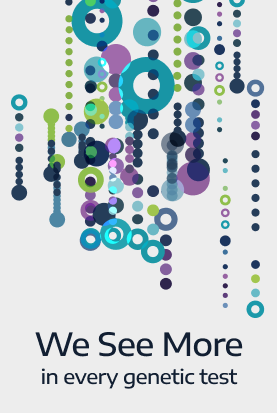
ONE TEST, DUAL DIAGNOSIS
IriSight® Case Study
Clinical presentation
An expectant mother underwent anatomy scans at 17 and 22 weeks gestation with the following findings:
- Cystic hygroma
- Hydrops fatalis
- Severe fetal growth restriction
- Polydactyly
Previous genetic testing
Testing was performed with negative results including:
- Chromosomal microarray

IriSight® Testing
was ordered because of its ability to identify all major variant types in a single test.
Results and interpretation
Variantyx IriSight® testing identified pathogenic, compound heterozygous variants in the CHRND gene: a maternally inherited single nucleotide deletion and a paternally inherited SNV.
IriSight® testing also identified two heterozygous, paternally inherited, likely pathogenic single exon deletions in the HOXD13 gene.
Diagnosis: Congenital myasthenic syndrome, Autosomal dominant skeletal abnormalities of the hands and feet

Uniform data from WGS clearly shows both inherited CHRND variants: a single nucleotide deletion and SNV (top). It also shows the two, single exon deletions, both with breakpoints within the first intron of HOXD13 (bottom).
The Variantyx Difference
Why was this dual diagnosis uniquely possible with IriSight® testing, and not possible with other tests?
-
Both the single exon deletions and the small sequence changes are below the limit of detection for CMA. Both diagnoses are missed.
-
If it had been ordered, exome testing could have detected the small sequence changes, potentially making the congenital myasthenic syndrome diagnosis. However, the AD skeletal abnormalities diagnosis would have been missed as single exon deletions are not detectable by exome testing.
Variantyx genome analysis has a detection range from 1 bp to whole chromosomal events. It is the only test that is capable of identifying all of the variants, making the dual diagnosis possible. In our experience, ~6% of prenatal cases result in a dual diagnosis.
Want similar results for your patients?
Connect with a Clinical Specialist to find out how easy it is to bring the power of whole genome sequencing into your practice.


